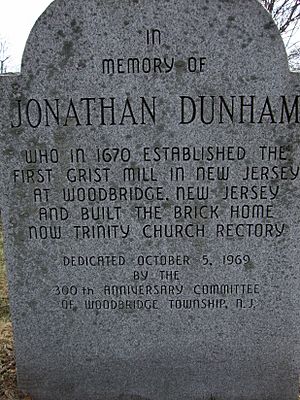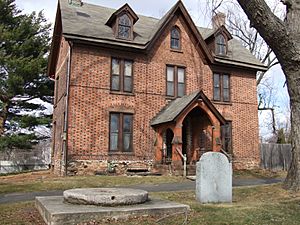Jonathan Singletary Dunham facts for kids
Quick facts for kids
Jonathan Singletary, later Dunham
|
|
|---|---|

Memorial at Trinity Episcopal Church in Woodbridge Township, New Jersey
|
|
| Born |
Jonathan Singletary
January 17, 1640 |
| Died | September 6, 1724 (aged 84) |
| Spouse(s) | Mary Bloomfield |
Jonathan Dunham was an important early settler in Woodbridge Township, New Jersey. He was born on January 17, 1640, and passed away on September 6, 1724. In his younger years, he was known as Jonathan Singletary. He built the very first gristmill (a mill for grinding grain into flour) in New Jersey. You might also find it interesting that he was an ancestor of former US President Barack Obama.
Contents
Jonathan Dunham's Early Life and New Home

Jonathan Singletary, who later became known as Jonathan Dunham, was born on January 17, 1640. His birthplace was Salisbury, Massachusetts. His parents were Richard Singletary and Susanna Cooke.
Jonathan married Mary Bloomfield. She was related to Joseph Bloomfield, who later became a governor of New Jersey. The town of Bloomfield, New Jersey is named after him.
Moving to New Jersey
Jonathan and Mary moved to Woodbridge Township, New Jersey. This was the first official township in New Jersey. It was given its charter (official permission) by King Charles II on June 1, 1669.
When Jonathan moved to New Jersey, he started using the last name Dunham. All of his children also used the Dunham name. This was different from his brothers, who kept the Singletary name.
Building the First Gristmill
In Woodbridge, Jonathan Dunham received a large piece of land. The new Governor of New Jersey gave him about 213 acres (about 0.86 square kilometers). On this land, Jonathan built something very important: the first gristmill in New Jersey.
A gristmill is a place where grain, like wheat or corn, is ground into flour. This was a vital service for early settlers. It helped them make bread and other foods.
Public Service and More Land
After his gristmill became successful, Jonathan Dunham became involved in public life. He served as the Clerk for the Woodbridge Township Court. He also worked as an overseer of highways, helping to manage the roads.
In 1673, he was elected to the New Jersey General Assembly. This was like a local government body for the area. He also received more land, about 203 acres (about 0.82 square kilometers). He bought many other pieces of land in both New Jersey and Massachusetts.
Jonathan Dunham's Legacy
Jonathan Dunham passed away in Woodbridge, New Jersey, in 1724. The house he built in 1671 is still standing today. It is known as the Jonathan Singletary Dunham House. It now serves as the Rectory (the home for the priest) of the Trinity Episcopal Church.
A local historian, Rev. Joseph W. Dally, described Dunham as a very energetic person. He said that when Dunham decided to do something, he worked hard until it was successful. Many of his relatives settled near him. Because of this, the area was known as "Dunhamtown" for many years.
Memorials and Millstone
Today, you can see one of the original millstones that Jonathan Dunham used. It is placed in front of the Trinity Church Rectory. There are also two special plaques there to remember him.
One plaque says that the millstone was placed there in 1948. It was to celebrate 250 years of Trinity Church. The other plaque was dedicated in 1969. It honors Jonathan Dunham for building the first gristmill in New Jersey in 1670. It also mentions that he built the brick house that is now the Trinity Church Rectory.
Notable Descendants of Jonathan Dunham
Jonathan Dunham has many interesting descendants. Here are a few:
- Perry Donham (born 1960): A Computer Science Professor at Boston University.
- Stanley Armour Dunham (1918–1992): He was the maternal grandfather of Barack Obama.
- Ann Dunham (1942–1995): An American anthropologist and the mother of Barack Obama.
- Barack Obama (born 1961): The 44th President of the United States.
- Malia and Sasha Obama (born 1998 / 2001): Daughters of Barack Obama.
- Joseph Bloomfield (1753–1823): The 4th Governor of New Jersey.

